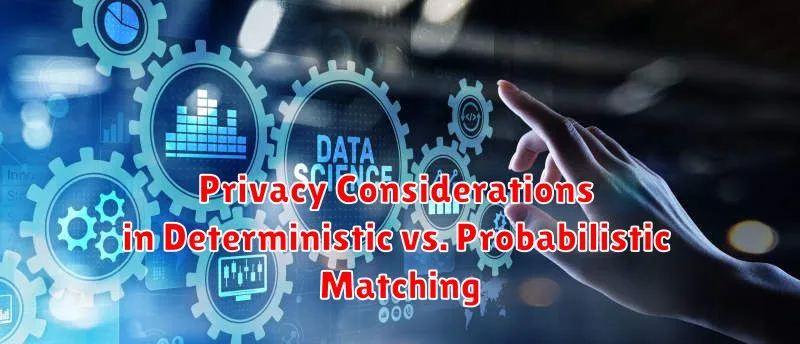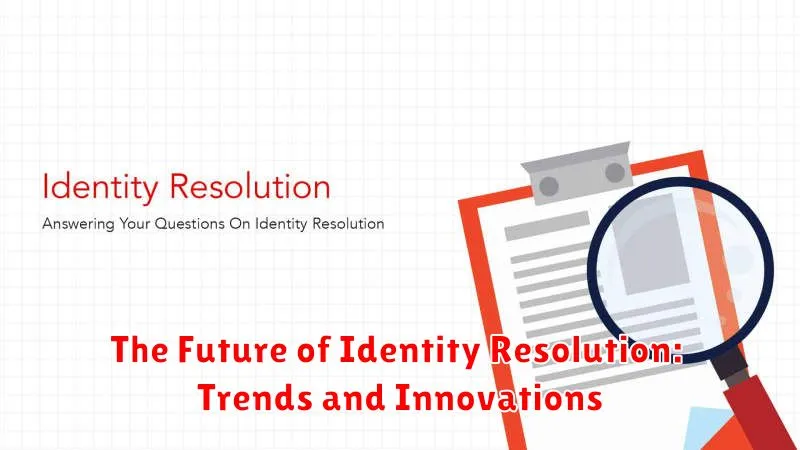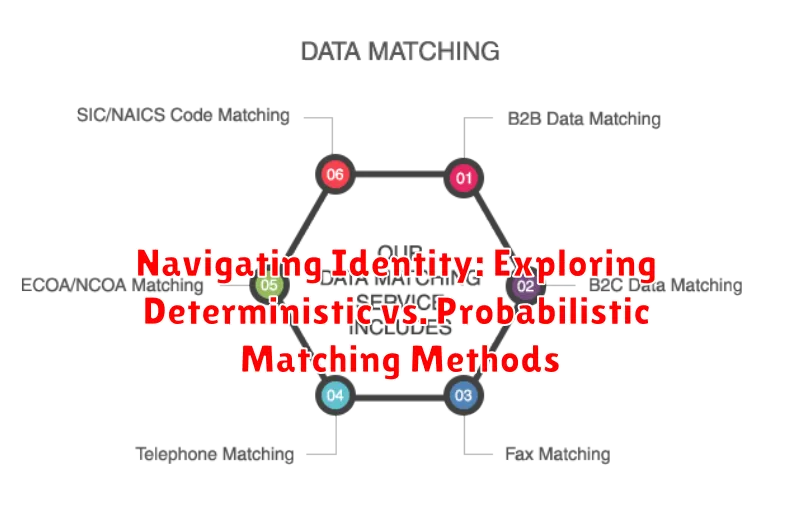In today’s data-driven world, the ability to accurately link and consolidate records representing the same entity is paramount. This process, often referred to as entity resolution or record linkage, forms the backbone of numerous critical applications, from customer relationship management (CRM) and fraud detection to healthcare data integration and national security initiatives. This article delves into the core methodologies employed in this vital task, specifically exploring the contrasting approaches of deterministic matching and probabilistic matching. Understanding the nuances of each method is crucial for organizations seeking to build robust and reliable data integration strategies, ensuring data quality and informed decision-making.
The choice between deterministic and probabilistic matching techniques hinges on a variety of factors, including the quality and completeness of the available data, the acceptable level of error, and the computational resources available. While deterministic matching relies on predefined, exact matching rules to identify corresponding records, probabilistic matching leverages statistical models to estimate the likelihood of two records representing the same entity, even with imperfect or incomplete data. This comprehensive exploration will examine the strengths and weaknesses of each approach, providing a framework for understanding when and how to effectively implement these identity resolution methods in various contexts. We will also consider the common challenges and emerging trends in the field of data matching, enabling readers to navigate the complexities of data integration with confidence.
Defining Deterministic Matching: A Precise Approach
Deterministic matching, also known as exact matching or rule-based matching, is a method of identity resolution that relies on predefined rules and direct comparisons between data points to identify matching records. This approach demands an exact match across specified identifying fields, such as name, address, date of birth, or a combination thereof.
The core principle of deterministic matching lies in its requirement for complete agreement. If a single designated field fails to match precisely, the records are considered distinct. This characteristic makes deterministic matching highly accurate when dealing with clean and standardized data.
Key features of deterministic matching include:
- Predefined Rules: Matches are determined by a set of explicitly defined rules.
- Exact Match Requirement: Records must match perfectly on the specified fields.
- High Accuracy: Offers high precision with clean, standardized data.
- Limited Scalability: Can be challenging to scale with large, diverse datasets.
Understanding Probabilistic Matching: Leveraging Algorithms
Probabilistic matching, in contrast to deterministic matching, employs algorithms and statistical models to determine the likelihood that two records refer to the same entity. This approach acknowledges the inherent imperfections and inconsistencies present in real-world data.
Instead of requiring exact matches on key identifiers, probabilistic matching calculates a match score based on the weighted sum of agreement and disagreement across multiple fields. Common algorithms used include:
- Bayesian Networks: These networks represent probabilistic relationships between variables, allowing for complex dependencies to be modeled.
- Fellegi-Sunter Model: A foundational model that estimates the probability of a true match based on the observed agreement patterns.
- Machine Learning Algorithms: Supervised learning techniques, such as Support Vector Machines (SVMs) or Random Forests, can be trained to classify record pairs as matches or non-matches.
These algorithms often incorporate fuzzy matching techniques to account for typographical errors, abbreviations, and variations in data entry. The output is a probability score, which is then compared to a predefined threshold to classify record pairs as matches, non-matches, or requiring manual review.
Key Differences Between Deterministic and Probabilistic Matching
The core distinction between deterministic and probabilistic matching lies in their approach to identity resolution. Deterministic matching relies on exact matches of predefined identifiers, such as name, address, or date of birth. If all required fields match precisely, a record is considered a match.
In contrast, probabilistic matching employs algorithms and statistical models to assess the likelihood of two records belonging to the same identity. It considers partial matches, variations in data entry, and data quality, assigning a probability score indicating the confidence level of a match.
Here’s a brief overview:
- Matching Criteria: Deterministic uses exact matches; Probabilistic uses algorithms and partial matches.
- Accuracy: Deterministic offers high accuracy when data is clean and consistent; Probabilistic is more resilient to data variations.
- Scalability: Deterministic can struggle with large datasets due to its rigidity; Probabilistic scales better due to its flexibility.
- Complexity: Deterministic is simpler to implement; Probabilistic requires more sophisticated setup and tuning.
The Importance of Data Quality in Both Matching Methods
Regardless of whether deterministic or probabilistic matching is employed, data quality is paramount. Inaccurate, incomplete, or inconsistent data can severely compromise the effectiveness of either method. Poor data quality leads to false positives (incorrect matches) and false negatives (missed matches), undermining the integrity of identity resolution.
For deterministic matching, which relies on exact matches, even minor discrepancies in data fields (e.g., a misspelled name or an incorrect address) can prevent a successful match. Therefore, rigorous data cleansing and standardization are essential prerequisites.
While probabilistic matching is more tolerant of imperfect data, it is not immune to the negative effects of poor quality. Noise in the data can skew the algorithms, leading to inaccurate probability scores and ultimately, flawed matching decisions. Investment in data quality initiatives is thus a critical success factor for both approaches.
Use Cases for Deterministic Matching: When Accuracy Matters Most
Deterministic matching excels in scenarios where data accuracy and minimizing false positives are paramount. These use cases typically involve highly sensitive information or situations where even minor errors can have significant consequences.
Examples of Ideal Use Cases:
- Healthcare Records: Precisely linking patient data across different systems is crucial for accurate diagnoses, treatment plans, and billing.
- Financial Transactions: Ensuring the correct identification of individuals involved in financial transactions is essential for fraud prevention and regulatory compliance.
- Law Enforcement: Accurately identifying suspects and victims is critical for investigations and legal proceedings.
- Government Identification: Linking citizens to their respective records requires a high degree of accuracy to ensure proper allocation of benefits and services.
In these situations, the need for absolute certainty outweighs the ability to match records based on probabilities. Deterministic matching, with its reliance on exact matches of key identifiers, provides the necessary level of confidence.
When to Use Probabilistic Matching: Scaling and Flexibility
Probabilistic matching excels in scenarios demanding scalability and adaptability, particularly when dealing with large, disparate datasets. Unlike deterministic matching, it doesn’t require perfect matches on specific fields, making it suitable for situations where data is inconsistent, incomplete, or contains errors.
Consider probabilistic matching when:
- Handling high volumes of data from various sources.
- Data quality is questionable or inconsistent.
- Fuzzy matching is required due to variations in data entry (e.g., nicknames, misspellings).
- The goal is to identify potential matches even if a definitive match is not possible.
This approach allows for a more flexible and nuanced view of identity resolution, enabling organizations to connect records that might be missed by more rigid methods. Its capacity to assign probabilities to matches allows for prioritization and further review, optimizing resource allocation.
Privacy Considerations in Deterministic vs. Probabilistic Matching

Both deterministic and probabilistic matching methods raise significant privacy concerns, albeit in different ways. Deterministic matching, reliant on direct identifiers, poses risks if the linked data is compromised, potentially exposing sensitive information directly. The accuracy of deterministic matching means that once a link is established, the connection is considered definitive, which can have serious implications if incorrect or misused.
Probabilistic matching, while using a more nuanced approach, aggregates multiple data points to infer identity. This can lead to re-identification risks, even when direct identifiers are masked or absent. The reliance on algorithms and statistical models necessitates careful attention to data minimization and transparency, as the inferences drawn may not always be accurate, potentially leading to unfair or discriminatory outcomes. It is essential to implement robust anonymization techniques and clearly define the purpose and scope of data usage for both methods to mitigate privacy risks.
The Future of Identity Resolution: Trends and Innovations

The field of identity resolution is rapidly evolving, driven by advancements in technology and the increasing complexity of data landscapes. Several key trends are shaping its future trajectory.
Emerging Trends
- AI and Machine Learning Integration: Increasingly, sophisticated algorithms are being employed to enhance matching accuracy and automate processes. This includes deep learning models capable of handling complex data variations.
- Real-time Matching: The demand for immediate identity resolution is growing, necessitating solutions that can process data streams in real time. This is particularly relevant in fraud detection and customer experience personalization.
- Increased Focus on Privacy-Enhancing Technologies (PETs): Techniques like differential privacy and homomorphic encryption are gaining traction to ensure data privacy during identity resolution processes.
- Graph Databases: These are becoming more prevalent for representing and analyzing complex relationships between identities, enabling more accurate and comprehensive matching.
- Cloud-Based Solutions: Cloud platforms offer scalability and flexibility, making them attractive for organizations managing large datasets and requiring robust identity resolution capabilities.
These innovations promise to deliver more accurate, efficient, and privacy-conscious identity resolution solutions in the years to come.
Combining Deterministic and Probabilistic Matching for Enhanced Accuracy
The synergistic application of deterministic and probabilistic matching offers a powerful approach to maximize accuracy in identity resolution. By strategically combining these methodologies, organizations can leverage the strengths of each to overcome their individual limitations.
Typically, a deterministic matching process is initiated to identify clear and unambiguous matches based on exact data point agreement. Subsequently, probabilistic matching is applied to evaluate potential matches among the remaining records, assigning scores based on the likelihood of a match given the available data. This tiered approach ensures high precision while also capturing matches that might be missed by a strictly deterministic methodology.
This combined strategy is particularly useful in scenarios with imperfect or incomplete data, enabling organizations to achieve a more comprehensive and accurate view of their data landscape. The resulting enhanced accuracy translates to improved decision-making, more effective marketing campaigns, and a stronger understanding of customer relationships.

